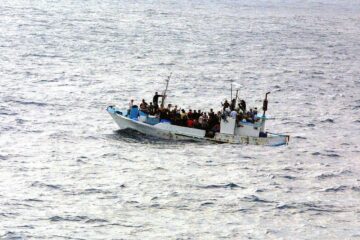![]()
Introduction:
Biological weapons, like chemical or nuclear weapons, are internationally recognized as ‘weapons of mass destruction’ because they are capable of a high order to cause destruction or causing mass casualties. Since their use is against the law of humanity, it is reprehensible and morally and legally repugnant. The use of these weapons in the conduct of hostilities is prohibited because they are by nature discriminatory. Another justification for the imposition of ban on the use of biological weapons is a well-established rule of international humanitarian law according to which the use of means and methods of warfare which are of a nature to cause superfluous injury or unnecessary suffering is prohibited. Excessive injury or suffering which is not of proportion to the military advantage sought is a general criterion for determining whether or not a weapon is of a nature to cause superfluous injury or unnecessary suffering.
What is Biological Weapons Convention?
The Convention on the Prohibition of the Development, Production and Stockpiling of Bacteriological (Biological) and Toxin Weapons and on their Destruction also known as Biological Weapons Convention (hereinafter referred to as “BWC”) has been hailed and heralded as a first multilateral disarmament treaty to ban the production and use of an entire category of weapons. It effectively prohibits the development, production, acquisition, transfer, stockpiling, and use of biological and toxic weapons. It currently has 183 members and four signatories (Haiti, Somalia, Egypt, Syria and Tanzania). There are ten states (Chad, Comoros, Djibouti, Eritrea, Israel, Kiribati, Micronesia, Namibia, South Sudan and Tuvalu) which have neither signed nor ratified the BWC[i]. BWC is a multilateral treaty of indefinite duration that is open to any country.
The BWC:
- Prohibits State Parties from developing, producing or acquiring biological agents or toxins which don’t have any reason for a peaceful or defensive purpose;
- Prohibits States Parties from developing, producing or acquiring equipment to deliver biological agents or toxins for hostile purposes;
- constrains States Parties to damage or divert to peaceful purposes their current stocks of forbidden items;
- bans States Parties from passing on possession of prohibited objects to anyone or otherwise assisting in the manufacture or acquisition of biological weapons;
- safeguards the rights of States Parties to transfer equipment, materials, and scientific and technological data for peaceful purposes in order to prevent impeding their economic and technological advancement;
- ensures that States Parties cooperate in resolving any issues with the help of consultation and in carrying out any investigation introduced by the UN Security Council; and
- Commits States Parties to give aid to others that have been assailed through biological weapons.
Importance of BWC
The BWC depicts the international community’s determination to prohibit and prevent biological warfare and the intentional use of disease as a weapon. Being the earliest disarmament treaty to ban an entire class of weapons, the BWC is a crucial legal and political tool that augments the widespread condemnation of biological weapons. This Convention complements the Geneva Protocol, which banned biological warfare methods in the year 1925. Although there is no provision in the BWC which explicitly prohibits the use of biological weapons but it is still considered to be a violation of the Convention as reaffirmed in the Final Declaration of the 1996 Treaty Review Conference. By representing a global will and establishing an international standard, it has built confidence and helped to deter countries from acquiring biological weapons for more than 30 years.
Historical Development of BWC
Biological weapons have been used as early as 1346 when the Mongols catapulted dead bodies contaminated with plague over the walls of the Crimean city of Kaffa. Although the use of biological weapons is prohibited under customary as well as international humanitarian law, the legal framework banning both chemical and biological warfare began to develop 500 years later, in the late 19th century[ii]. This landmark development was a culmination of continuous and sustained efforts for the international community to eliminate or regulate the use of these weapons in the conduct of hostilities. Before the turn of the preceding century, biological weapons were clubbed together with poison or poisonous weapons and were accordingly governed by the 19th-century treaties and conventions like the Hague Regulations. In today’s world, possessing poison or poisoned weapons is a war crime in international armed conflicts under the Statute of the International Criminal Court. The Geneva Gas Protocol, 1925 was, however, the first international convention which not only separated biological and chemical weapons from poison or poisoned weapons but also forbade their use independently of the prohibition of poisonous weapons. But even that protocol, which was adopted in response in a large scale use of chemical and biological weapons during the First World War. This fact prompted the United Nations to take up the agenda of disarmament and non-proliferation of weapons of mass destruction, including biological weapons. But negotiations on an international convention dealing specifically with biological weapons took several turns and twists and was a result of prolonged efforts by the international community that the BWC, was opened for signature on 10th April 1972.
Verification
The Treaty authorizes the States Parties to consult with each other and cooperate, bilaterally or multilaterally, to solve compliance problems. If the States Parties believe that other members are violating the Convention then the treaty allows the Parties to file a complaint with the United Nations Security Council (UNSC). The UNSC can then investigate these complaints. However, this power has never been invoked. Security Council voting rules give China, France, Russia, the United Kingdom, and the United States veto power over Security Council decisions, including those to conduct BWC investigations[iii].
Implementation
BWC does not have any dedicated international organization charged with overseeing its implementation unlike its nuclear and chemical counterparts (The Nuclear Non-Proliferation Treaty and Chemical Weapons Convention). The State parties sought to overcome this institutional deficit by creating the Implementation Support Unit (ISU) in 2007. The purpose of the ISU is to help States Parties to implement the Convention rather than carrying the implementation tasks itself. For this reason, the Convention needs an enforcement protocol. Efforts for the same were made in the past but were aborted in 2001 due to divergent positions of States Parties on this issue. National implementation measures are the main pillar of implementing mechanisms as envisaged in the Convention. “National implementation measures are measures put in place by States Parties to the Convention for the purpose of prohibition and prevention of the development, production, stockpiling, acquisition, or retention of the agents, toxins, weapons, equipment, and means of delivery, within its territory, under its jurisdiction or under its control anywhere[iv]”. India is committed to the United Nations policy relating to disarmament and non-proliferation of weapons of mass destruction, including biological weapons. Its overall approach to BWC has been profoundly shaped and influenced by these factors.
Legal basis for the adoption of national measures by state parties has been laid down in Article IV of the Convention. As State Parties have different national circumstances and legal systems which necessitate different approaches to implementing the provisions of the Convention, drafters of the Convention left it to the discretion of the State Parties to decide the precise details in accordance with their constitutional processes, measures which are necessary to accomplish the tasks assigned to them under the Convention[v]. In addition to this, Article III requires “each State Party to this Convention to undertake not to transfer to any recipient whatsoever, directly or indirectly, and not in any way to assist, encourage, or induce any State, group of States or international organizations to manufacture or otherwise acquire any of the agents, toxins, weapons, equipment or means of delivery specified in Article I of the Convention[vi]” Furthermore, at the Sixth Review Conference, States Parties agreed to designate national points of contact for implementation and to inform the ISU, which has been assigned a clearinghouse role in facilitating national implementation, not only about the designated national point but also domestic measures taken under both the prospective and promotional aspects of the Convention. A State’s legislative drafters can turn for assistance to the ISU, verification Research, Training and Information Center, the Advisory Service of the International Committee of the Red Cross (ICRC) and European Union (EU)[vii].
Indian State Practice and State Legislation
India is one of the greatest votaries of disarmament of weapons of mass destruction including biological and chemical weapons because when used in an armed conflict these weapons may cause enormous loss of humanity and property. It is because of this reason that India signed the BWC on 15th January 1973 and deposited instrument of ratification on 15th July 1974. India is also party to the 1925 Geneva Protocol[viii], for complementing which the BWC was successfully negotiated and concluded by the subscribing States, with a reservation of a right to retaliate, which has now become illegal and unjustified in view of legal developments that have taken place since 1925. India’s commitment to outlawry of BWC is not only reflected in its compliance of the treaty obligations but also in its relentless efforts to strengthen the BWC regime by participating in all BWC related meetings. It found in Review Conferences, which are held every five years, a useful forum to reiterate its commitments to comply with all obligations under the BWC and air its views on issues concerning the operation of the Convention.
There are several National Rules and Regulations to enforce the BWC treaty. Indian Constitution gives a place of pride to rules to international law and treaty obligations[ix]. Article 51 states that “The State shall endeavour to (a) promote international peace and security; (b) maintain just and honourable relations between nations; (c) foster respect for international law and treaty obligations in the dealings of organised peoples with one another; and encourage settlement of international disputes by arbitration PART IVA FUNDAMENTAL DUTIES[x]”. While the power to conclude treaties with foreign powers is vested on the central executive[xi], parliament is vested with the power to enact laws for the implementation of treaties and decisions made at international conferences[xii].
Other Legislations are stated as follows:
- Weapons of Mass Destruction and Delivery Systems (Prohibition of Unlawful Activities) Act, 2005 (WMD): It is landmark disarmament legislation as it seeks to translate at the operational level India’s commitment to prevent the proliferation of weapons of mass destruction. The legislation builds upon the existing regulatory framework related to controls over the export of WMD usable materials, equipment and technologies[xiii]. It is an overarching and integrated legislation prohibiting unlawful activities in relation to weapons of mass destruction and their delivery system. Section 4 (a) of the WMD Act states the meaning of biological weapons as: “(i) microbial or other biological agents, or toxins whatever their origin or method of production, of types and in quantities that have no justification for prophylactic, protective or other peaceful purposes; and (ii) weapons, equipment or delivery systems specially designed to use such agents or toxins for hostile purposes or in armed conflict[xiv]”
- The Foreign Trade (Development and Regulation) Act, 1992: It provides for the development and regulation of foreign trade by facilitating imports into and augmenting exports from India, regulates among other things, import and export of microorganisms and toxins. The legislation also covers plant pathogens and genetically modified organisms.
- The Environmental (Protection) Act, 1986: This Act specifically deals with the problem of management and ‘handling of wastes and hazardous wastes’. Section 6 of the Act specifically empowers the Central government to make rules on various items including the procedures and safeguards for the handling of hazardous substances, and the prohibition and restriction on the handling of hazardous substances in different areas[xv].
- Manufacture, Storage and Import of Hazardous Chemical Rules, 1989: This deals with hazardous chemicals separately and in a comprehensive manner.
- The Disaster Management Act, 2005: This is another legislation of far-reaching significance and hence may be of great help in mitigating the adverse effects of the misuse of micro-organisms and illegal use of biological agents and toxins by non-state actors and hostile countries[xvi].
Confidence Building Measures (CBM’s)
The Second Review Conference (1986) established an annual exchange of information, known as, Confidence Building Measures (CBM’s). CBM’s are intended to reduce the occurrence of ambiguities, doubts and suspicious and improve international cooperation in the field of peaceful biological activities. An Ad-Hoc meeting of scientific and technical experts was held from March to April 1987, to establish the precise format of the CBMs. The third Review Conference modified and considerably expanded the CBMs in 1991. The CBMs include the exchange of data on research centres and laboratories, exchange of information on national biological defence research and development programs; exchange of information on outbreaks of infectious diseases and similar occurrences caused by toxins, encouragement of publication of results and promotion of the use of knowledge, the active promotion of contacts, declaration of legislation, regulations and other measures, declaration of past activities in offensive and/or defensive biological research and development programs and declaration of vaccine production facilities. The CBMs have not been modified since 1991, although the Sixth Review Conference in 2006 agreed on various improvements to the mechanism for submission and distribution of BWC information. India recognizes CBMs as an important transparency measure to assist in the implementation of the Convention. It also believes that CBMs are not an alternative to an effective multilaterally agreed mechanism for verification compliance. According to India in the BWC, verification compliance is critically important for State Parties in order to be collectively reassured about the realization of the provisions of the Convention.
CBMs are to be submitted to the BWC Implementation Support Unit in the Geneva Branch of United Nations Office for Disarmament Affairs no later than 15 April each year[xvii]. The information provided covers the previous calendar year (for example, you should submit your CBM covering the calendar year 2019 no later than 15 April 2020)[xviii].
Conclusion
To sum up, the BWC is a landmark multilateral disarmament treaty which has outlawed an entire variety of weapons of mass destruction and withstood the test of time and by and large served the purpose for which it was adopted in 1972 and India has always adopted a realistic, pragmatic and constructive approach towards the BWC and its implementation.
References:
[i] kimball, D. (2019). The Biological Weapons Convention (BWC) At A Glance | Arms Control Association. Armscontrol.Org. https://www.armscontrol.org/factsheets/bwc
[ii] Biological Weapons Convention | Biological Weapons Warfare Treaty | NTI. (n.d.). Www.Nti.Org. Retrieved August 30, 2020, from https://www.nti.org/analysis/articles/biological-weapons-convention/
[iii] Supra note i
[iv] The Biological Weapons Convention, Article IV.
[v] Ibid.
[vi] Supra note iv, a.III
[vii] Australian Red Cross Handbook on International Humanitarian Law Mooting. (n.d.). Retrieved August 30, 2020, from https://static1.squarespace.com/static/55861728e4b0403b40cdba08/t/5e9eeeaf1a1c2040aad51a5b/1587474902992/IHLHandbook2020
[viii] 1925 Geneva Protocol – UNODA. (2019). Un.Org. https://www.un.org/disarmament/wmd/bio/1925-geneva-protocol/
[ix]CHAPTER 3 CONSTITUTIONAL PROVISIONS REGARDING TREATIES, INTERNATIONAL AGREEMENTS AND CONVENTIONS WITH FOREIGN COUNTRIES. (n.d.). Retrieved August 30, 2020, from https://shodhganga.inflibnet.ac.in/bitstream/10603/166214/10/10_chapter_3.pdf
[x] The Constitution of India, a.51
[xi] Ibid., a. 246
[xii] Ibid., a. 253
[xiii] Biological Weapons – UNODA. (2017). Un.Org. https://www.un.org/disarmament/wmd/bio/
[xiv] Weapons of Mass Destruction Act, 2005, s.4(a).
[xv] The Environment (Protection) Act, s. 6(d)
[xvi] The Disaster Management Act, 2005, s.2(d)
[xvii] Where global solutions are shaped for you | Disarmament | The Confidence-Building Measures (CBMs). (n.d.). Www.Unog.Ch. Retrieved September 1, 2020, from https://www.unog.ch/80256EE600585943/(httpPages)/5E2E8E6499843CCBC1257E52003ADED4?OpenDocument
[xviii] Ibid.



0 Comments